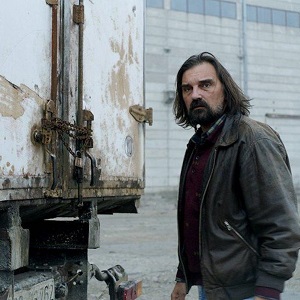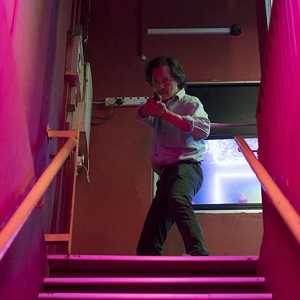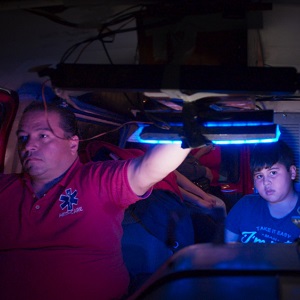The 48th edition of New Directors/New Films runs March 27th – April 7th. Here’s our first dispatch. Included — very much intentionally — in our second and final dispatch from the fest is a film that isn’t actually playing the fest at all, at least not anymore. The exact reasons as to why that film isn’t playing (its screenings were canceled at the very last minute) are not the stuff of public knowledge at the time of this writing, but consider this: Qiu Sheng’s Suburban Birds is the fourth official selection at a major film festival to have its screenings cancelled, with only vague reasons given as to why, in less than two months time. All four of these films are Chinese productions — the others being Zhang Yimou’s One Second and Derek Tsang’s Better Days at the Berlinale, as well as the twofer of Lou Ye’s The Shadow Play and the accompanying Ma Ying Li film Behind the Dream: A Documentary on the Shadow Play (which we’ll count as one “selection,” to be nice), at the Hong Kong International Film Festival. This is a problem that we don’t want to be party to, so below you’ll find our take on Suburban Birds, a film that we hope others will have the opportunity to see soon. You’ll also find a film offering a further consideration of Chinese censorship (Zhu Shengze’s Present.Perfect), heavily geopolitical films from Serbia (Ognjen Glavonic’s The Load) and Singapore (Yeo Siew Hua’s A Land Imagined), a documentary about citizens taking up the slack of the government through the private sector (Luke Lorentzen’s Midnight Family), and finally, a “Duchampian” contemplation of what even constitutes art anymore (Peter Parlow’s The Plagiarists). ND/NF may have lost the battle, when it comes to Suburban Birds, but thanks to its always-adventurous, probing, and provocative programming, it sure isn’t losing the war.
Update (April 4, 2019): Suburban Birds screenings are back on at ND/NF this weekend, after the film received the proper certificate from Chinese authorities for its foreign release. Learn more over at IndieWire.
The enduring impulse to defamiliarize — that is, to (re-)present something as novel or new — is at the heart of Peter Parlow’s The Plagiarists. Directed from a script by Robin Schavoir and James N. Kienitz Wilkins, this 76-minute feature opens in programmatic, low-budget indie form: a pair of hipster intellectual-artist-types, Anna (Lucy Kaminsky) and her boyfriend Tyler (Eamon Monaghan), have some car trouble on their way back from a friend’s bougie, oft-Airbnb-ed vacation home. In short order, Clip (Michael “Clip” Payne), an older black man from around the neighborhood, offers them some help, and the couple soon find themselves in his home for the evening. As liquor and conversations start to flow, we learn that Anna is a budding novelist writing her first book, while Tyler is an aspiring filmmaker who works mainly as a DP on commercials. Those who might want to take this as a sly send-up of American indie filmmaking pretensions — both in front of and behind the camera — will find much to support that assessment. (Tyler namedrops Dogme 95 at one point, though he can’t remember whether it comes from Denmark or Norway.) And yet, with its particular attention to film/video formats (it was shot on an ‘80s TV-news camera), The Plagiarists reveals itself to be something more maddeningly, if also productively, contradictory. In particular, the film hinges on an extended, eloquent childhood reminiscence from Clip that, Anna discovers months later, was plagiarized in its entirety from Norwegian writer Karl Ove Knausgård. “This is not about art!” Anna exclaims, visibly unsettled by this discovery. And yet it is. (It’s no accident that the snippet we hear of Anna’s novel — not a memoir, she emphasizes — relays the experiences of someone she’d met on a trip to New Guinea.) Bringing in a skein of talking points, including artistic (mis)representation and cultural appropriation, The Plagiarists explores the enduring, Duchampian question of what constitutes art, especially in a content-saturated environment where the notion of the “readymade” feels more fraught than ever. Appropriately, then, this film only becomes knottier — and thereby more interesting — the more one tries to untangle it. Lawrence Garcia

Suburban Birds opens with an iris shot, a formal gesture that likens it to Feng Xiaogang’s recent I Am Not Madame Bovary. Quickly, Qiu Sheng’s film reveals this to be the POV of a land surveyor looking through his theodolite. In its first half, the film is composed mostly of long takes, with constant, horizontal and lateral movements, and zooms, as the camera reacts to characters arriving, leaving, or pointing at something — naturally reminiscent of South Korean filmmaker Hong Sang-soo, especially those zooms. Qiu, a first-time director, does a commendable job precisely controlling the visual field of his film, while his narrative peels back layers of a story that revolves around an investigation of sinking terrain, and the evacuation that the problem causes. In this first half, the totalizing effect of the camera captivates the viewer when the plot doesn’t — but in the middle, things shift. A character starts reading a diary written by a child, and we see that story play-out. A group of school children go on outdoor excursions, chat amongst each other, and tentatively explore their romantic inclinations. Sadly, in this section of the film, the formal qualities of Suburban Birds aren’t nearly as jarring, nor exciting. Though even here, there’s something to the accomplishment of Qiu’s work with child actors, which resonates with a realism akin to some of Hirokazu Kore-eda’s films. As things continue to meander, Qiu’s ambitions expanding with each new passage of his film, these parts don’t quite add-up. Individual moments are clever and amusing, like birds singing referring back to an alarm on a smartphone, or the way the children ironically belt “We’re the Communist Little League of China.” But Suburban Birds is a bit too derivative to be wholly exciting in its own right. Jaime Grijalba

The titular ‘land’ that’s ‘imagined’ in Yeo Siew Hua’s Golden Leopard-winning debut film manifests in two different ways, one explicitly physical (the ever-expanding continent of Singapore, forged through migrant labor via land reclamation) and one virtual (the online-generated ‘worlds’ that serve as a home for a globalized community). This suggests that Yeo’s film is one that interacts with its central political allegory on a philosophical level, where concerns of continental proliferation include a strong emphasis on dehumanization — and for about half of its runtime, A Land Imagined attempts to formulate such a multi-faceted critique. The twisty neo-noir uses the disappearance of a Chinese worker, Wang (Liu Xiaoyi), as its framing device and thematic starting point. This seemingly random event that nobody pays much attention to comes to represent the harsh reality of many foreign laborers – if you were to suddenly vanish one day, you can easily be replaced by five other migratory hirelings. In flashbacks, we see Wang coping with his hopeless existence by frequenting the eLover Cybercafe, a 24-hour den of Counter-Strike tournaments and despair. It’s here where Yeo reaches for something profound, linking the two distant realms — one fiction and one reality, both constructed inorganically — together through the lens of endless development and a rapid abandonment of individuality. But this also proves to be where Yeo’s critique skews incoherent, as he throws an inspidly spiritual twist into his missing-person mystery that weakens A Land Imagined’s overarching commentary in favor of less ambitious genre conventions. Paul Attard
There are fewer than 45 government-funded emergency ambulances in Mexico City — far from the sufficient number of vehicles needed to provide for the capital city’s nine million residents. This inadequacy has resulted in private, family-run businesses providing the same service, one of which is operated by the Ochoa family. Luke Lorentzen’s Midnight Family follows the Ochoas and, in the process, underlines issues plaguing the country’s healthcare system. The situation is dire: it takes 40 minutes for a boy with a gunshot wound to get an ambulance. More than simply prove the need for timely healthcare provisions, though, Midnight Family points to how for-profit healthcare can be disastrous. When the Ochoas help a highschool girl physically abused by her boyfriend, the girl almost immediately asks a question regarding the cost of her care, serving as a grim reminder that emergency treatment is something people are willing to forgo due to the price tag. And when the girl’s family is unable to pay, the Ochoas work through another night without compensation. They’re happy to have helped someone, of course, but they’re upset with the outcome. An early scene depicts the family’s home life, and reveals their unstable financial situation, a threat made all the more evident from their language, the tone of their voices, and their actions throughout the film. As such, Midnight Family’s consistent tension relies on two crucial components: both the urgency that defines the life of an EMT and the urgent struggle to resolve financial instability. In one of the film’s most painful sequences, police officers threaten to arrest the Ochoas for “stealing” the ‘bodies’ in their ambulance, a twofold frustration given that this interrogation not only prolongs the trip to the hospital, but also means the family could lose-out on this much-needed money. Midnight Family is consequently at its most compelling when it makes inextricable a link between the Ochoas’ morals and the government’s failed healthcare system — everything seems broken, and everyone just wants to survive. JMK






Comments are closed.